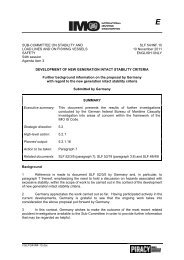Examination of the intact stability and the seakeeping behaviour
Examination of the intact stability and the seakeeping behaviour
Examination of the intact stability and the seakeeping behaviour
Create successful ePaper yourself
Turn your PDF publications into a flip-book with our unique Google optimized e-Paper software.
6.1 Variation <strong>of</strong> <strong>the</strong> GM values<br />
accelerations also decrease signicantly to values <strong>of</strong> about 3 m /s 2 .<br />
Table 6.2: Stability data for <strong>the</strong> midsized vessel<br />
Ballast arrival loading<br />
Value Unit<br />
condition<br />
KM 21.45 [m]<br />
KG 11.02 [m]<br />
GM solid 10.43 [m]<br />
Light ship Value Unit<br />
vcg LSW 15.13 [m]<br />
16<br />
14<br />
Maximum transverse acceleration on <strong>the</strong> bridge [m/s 2 ]<br />
12<br />
10<br />
8<br />
6<br />
4<br />
2<br />
Ballast arrival loading condition<br />
0<br />
2 4 6 8 10 12 14 16<br />
GM solid [m]<br />
Accident situation 1 Accident situation 2 Accident situation 3<br />
Figure 6.2: Vessel No. 01 in ballast arrival oating condition: Variation <strong>of</strong> GM solid<br />
6.1.3 Large vessel<br />
The large vessel for <strong>the</strong> detailed <strong>stability</strong> analysis is <strong>the</strong> Chicago Express. Its relevant data<br />
are listed in table 6.3, while more detailed data can be found in <strong>the</strong> appendix A.14 on page 72.<br />
The GM is varied around <strong>the</strong> ballast arrival GM solid = 12.40 m in both directions within a range<br />
<strong>of</strong> about GM ∼ = 5 ... 15 m.<br />
In gure 6.3 <strong>the</strong> resulting transversal accelerations on <strong>the</strong> bridge are shown related to <strong>the</strong><br />
varied GM solid values. For all three accident situations it follows a comparable curve slope. This<br />
time no signicant transversal accelerations occur in <strong>the</strong> ballast arrival loading condition. With<br />
a higher <strong>stability</strong>, than in <strong>the</strong> ballast arrival loading condition, <strong>the</strong> behavior <strong>of</strong> <strong>the</strong> vessel does<br />
not change. Fur<strong>the</strong>rmore all analysed GM solid values up to 14 m are realistically reachable for<br />
49

















